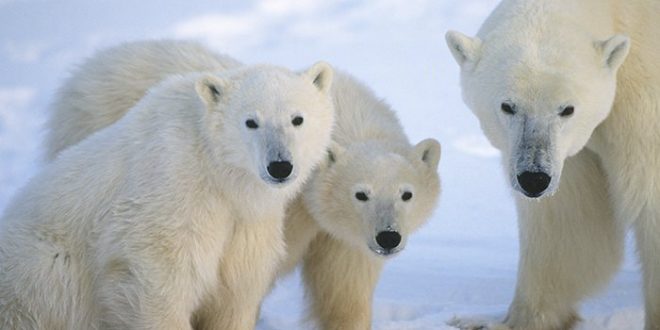Polar bears are one of the most threatened species in the planet. The world’s largest bear is constantly threatened to disappear especially with the melting of the Arctic sea ice.
There is a 70 percent chance that the global polar bear population — estimated at 26,000 — will decline by more than 30 percent over the next 35 years, a period corresponding to three generations, the study found.
“Loss of Arctic sea ice owing to climate change is the primary threat to polar bears throughout their range,” said the study, published this month in the Royal Society science journal Biology Letters.
The scientists looked at four polar bear eco-regions and 19 subpopulations, in the Arctic as well as Canada’s Hudson Bay. They analyzed sea ice data and the shrinking Arctic ice pack over a 35 year period from 1979 to 2014.
“Our findings support the potential for large declines in polar bear numbers owing to sea-ice loss, and highlight near-term uncertainty in statistical projections as well as the sensitivity of populations to different plausible assumptions,” said the study.
The United States has listed the giant bruins under the Endangered Species Act due to loss of habitat.
The new findings are in line with a recent study by University of Washington scientists, published in the science journal The Cryosphere.
In their report, the UW researchers said: “Their dependence on sea ice means climate warming poses the single most important threat to (polar bear) persistence.”
The new research, reported in Biology Letters, finds that sea-ice is retreating 3 to 9 days earlier and forming later by 3 to 9 days over every decade, and for all of the bear populations. The loss of sea ice amounted to nearly two months over the years of study.
By the middle of the century, bears will have to endure an additional seven ice-free weeks.
The bears live much of the year on ice flows, from which they hunt seals. They are already being forced ashore in the Arctic at such locations as Cooper Island north of Barrow in Alaska.
The steady rate of decline could cut the polar population to 9,000 later in the century, and eventually reduce habitat to the area of Baffin Island and western Greenland. Polar bear populations are already in decline in such areas as Alaska’s Beaufort Sea.
The Arctic has been warning at approximately twice the rate for the rest of the Earth, the result of carbon dioxide buildup in the atmosphere caused largely by emission of greenhouse gases.
Pollution has consequences. As the study notes:
“Anthropogenic climate change is the primary threat to the species because, over the long term, global temperatures will increase and Arctic sea ice will decrease as long as atmospheric greenhouse gas concentrations continue to rise.”
Agencies/Canadajournal
 Canada Journal – News of the World Articles and videos to bring you the biggest Canadian news stories from across the country every day
Canada Journal – News of the World Articles and videos to bring you the biggest Canadian news stories from across the country every day




This is not a study of polar bear populations, this is a review and projection of sea ice conditions. So, given that we apparently have 35 years of sea-ice data, what was the bear population 35 years ago and what is it now?
Incidentally, sea-ice trend is NOT a complete predictor of any animal population. The ecosystems will change and the animals will adapt and change their habits in ways we can’t predict. This is not denial of the issue, just contempt over a stupid article.